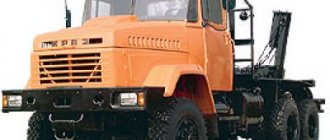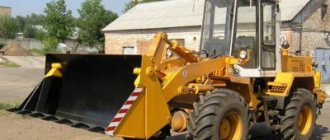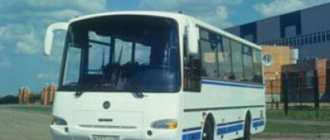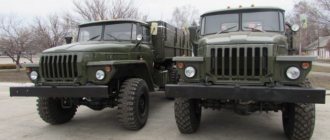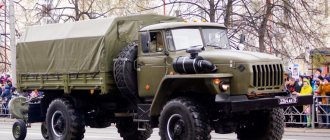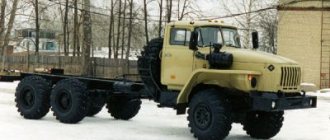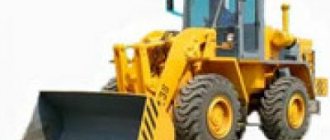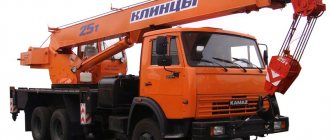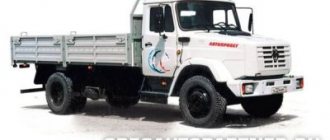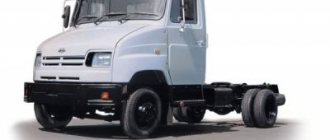For questions regarding the purchase of this equipment (ZIL 442300 4x2 truck tractor), terms of credit and leasing, service and warranty, please contact the plant’s dealers or official representative offices. Delivery of the ZIL 442300 4x2 truck tractor can be carried out either directly from the manufacturer or from sites in Moscow and other regions of the Russian Federation.
The ZIL truck tractor with a 4×2 wheel arrangement is designed for transporting various cargoes as part of a road train with special semi-trailers with a front reach of 1425 mm on all types of roads.
Other economic realities
However, different economic conditions brought not only freedom of enterprise, but also serious problems. If in previous times the flagship of the domestic automobile industry was provided with guaranteed sales of its products, now government funding for the company's main buyers - the Ministry of Defense and the agro-industrial complex - has decreased by 40% since 1992.
Sales of Zilov chassis, on which a wide range of bodies and special superstructures were mounted, also decreased. The plant's problems worsened. The main consumers of his products came under severe financial pressure, as a result of which the sales market declined sharply. Long-term intra-Union ties were also interrupted.
The ZIL dealer network consisted of about 100 regional sales representatives, who were previously structural divisions of the plant and used its funds. The company provided them with trucks and spare parts on a consignment basis. This system of relations caused significant delays in payment and was unprofitable for ZIL.
As for the products, the vehicles of the ZIL-431410 (ZIL-130) and ZIL-131 family are already quite outdated, and the more modern trucks ZIL-4331, ZIL-131N, ZIL-133D and their derivatives required modernization. At that time, work was actively underway to create a promising light-duty truck ZIL-5301.
Sports during development
The capital's automobile plant was in dire need of a major strategic partner. That’s when they remembered the Caterpillar Inc. concern, the first business contacts with which took place back in 1991. Then the specialists of the Zilov team, participating in road racing for the European Cup among trucks, drew attention to the powerful and very reliable 10-liter Caterpillar 3176 turbodiesel installed on some competitors' models.
After a more detailed acquaintance with the American engine, we decided to study the possibility of installing it on the ZIL-4421 racing truck, instead of the previously used KAMAZ and Cummins diesel engines. Technically, this did not present any particular difficulties, especially since the necessary experience in such matters was already available. A little later, to consolidate formal relations, the first meeting of Caterpillar representatives with the management of AMO ZIL took place. The result of the negotiations was an agreement to install a specially prepared Caterpillar engine on a ZIL racing truck.
Sports results were not slow to tell. The high technical parameters of the engine, multiplied by the growing experience of the leader of the factory racing team, Alexander Markin, allowed him to confidently enter the top five in two seasons from the third ten, taking prizes at certain stages of the competition.
The starting point for cooperation between AMO ZIL and Caterpillar was the ZIL-4421SE racing truck
Technical characteristics of the ZIL-442100 truck tractor
| Wheel formula | 4x2 | |
| Weight of the equipped truck tractor, kg | 5025 | |
| Distribution of load on the road from the curb weight through the tires, N (kgf) | front wheels | 29250 (2925) |
| rear axle | 21000 (2100) | |
| Load on fifth wheel coupling, kgf | 6200 | |
| Total weight of the truck tractor, kg | 11450 | |
| Distribution of load on the road from the total weight through the tires, N (kgf) | front wheels | 34500 (3450) |
| rear axle | 80000 (8000) | |
| Gross weight of towed semi-trailer, kg | 18175 | |
| Gross weight of the road train, kg | 23500 | |
| Turning radius, m | 6,9 | |
| Maximum speed of the road train, km/h | 85 | |
| Control fuel consumption of a road train at V=60 km/h, l/100 km | 24,4* | |
| Fuel tank capacity, l | 170 | |
* — On EX-12 tires.
Engine of truck tractor ZIL-442300
| Engine model | ZIL-645 |
| engine's type | diesel |
| Number and arrangement of cylinders | V8 |
| Working volume, l | 8,74 |
| Compression ratio | 18,5 |
| Power, hp (kW) | 185 (136) at 2800 min.-1 |
| Torque, kgf m (Nm) | 52 (510) at 1400-1600 min.-1 |
By special order, the model can be supplied with the CAT-3116 engine (185 hp). Model number ZIL-442311A.
The emergence of Novotrak
Other Caterpillar engines also attracted attention. To evaluate the real capabilities of overseas engines, in 1992, a van with a thermal body and a refrigeration unit was manufactured on the ZIL-433512 chassis, which was equipped with a 148-horsepower Caterpillar Cat 3114 diesel engine, as well as ZIL-4421 and ZIL-4423 truck tractors equipped with Cat engines 3116 TA with a power of 250 hp.
Moreover, the latest model was released in two versions, each of them was equipped with a separate sleeping compartment with side windows located behind the cabin and lower fairing skirts. But the cabins themselves were different. One of them, the serial one, received a roof-mounted volumetric aerodynamic fairing, and the other, the modernized one, was made taller and topped with horn bells.
At the end of August 1992, the mentioned samples were exhibited with great success at the Moscow Motorshow-92. The ZIL-4421SE racing tractor, as well as the line of diesel engines presented by Caterpillar, aroused interest.
The first van with a thermal body on the ZIL-433512 chassis, equipped with a Cat 3114 diesel engine, was manufactured in 1992
The Cat 3116 TA turbodiesel easily fit in the engine compartment of Zilov tractors
Truck tractor ZIL-4423 with a Cat 3116 TA engine, equipped with a separate sleeping compartment
In the fall of 1992, Caterpillar attracted its long-time partner PACCAR, represented by its member company Kenworth, to cooperate with AMO ZIL. In 1993, the structure was finally formed and the priority tasks of the interacting parties were determined. Soon, the corresponding agreement on organizing a joint venture was signed during a visit to Geneva by the then leaders of the company, President and General Director Valery Saikin, as well as Chairman of the Board of Directors of AMO ZIL Alexander Vladislavlev.
This is how the Novotruck joint venture appeared, and the date of its official registration was September 6, 1993. The founders of the newly formed organization, with equal share participation, were AMO ZIL on the Russian side, and Caterpillar and Kenworth on the American side. As a result of the transaction, a powerful industrial-financial alliance emerged, ready to enter the market with a modern, highly competitive product line.
Power and pride - these are the qualities ZIL trucks with Caterpillar engines should have had
AMO ZIL is the oldest and largest manufacturer of medium-duty trucks in Russia, uniting under its wing more than a dozen factories both in the capital of Russia and in other cities of the country. By the beginning of the 1990s, the fifth general reconstruction was almost completely completed at the parent enterprise, which brought it to the forefront of technological positions. Moreover, the equipment installed at the capital’s plant was in no way inferior to that at the disposal of its American partners.
No less famous were the products of Kenworth Inc., which, together with the American Peterbilt Motors Company and the English Foden Trucks, was part of the PACCAR Inc. corporation. Kenworth trucks, famous for their high quality workmanship and durability (mileage was 2–2.5 million km), successfully operated in fifty countries around the world.
Another version of the ZIL-4423 with an American engine, but with a high cabin and an aerodynamic body kit
Ten-ton ZIL-4514 dump truck with Cat 3208 diesel engine
PACCAR's annual production at that time reached 47 thousand trucks, and the company's skillful planning ensured profitability of production throughout its more than 80-year history of vehicle manufacturing.
The core of Kenworth's production program consisted of eight basic models, not counting numerous modifications. All produced trucks except one, according to American terminology, belonged to the 8th load capacity class, which consists of trucks with a gross weight of over 15 tons. The vehicles were made with a hood layout and a cabin over the engine, among them there are truck tractors, dump trucks, vans, all-wheel drive chassis for installation of various industrial equipment, etc.
Close production ties between American firms were determined by the fact that PACCAR installed over 30% of engines manufactured by Caterpillar on its trucks.
The agreement on the organization of the Novotrak joint venture from AMO ZIL was signed by General Director Valery Saikin
Former CEO Alexey Cherepkov, now working at the Moscow representative office of Caterpillar
Additional equipment of the ZIL 442100 truck tractor
Clutch
- Single-disc, friction, with peripherally located pressure springs.
- The diameter of the driven disk is 380 mm.
- The drive is hydraulic with pneumatic booster.
Transmission
- Nine-speed with rear planetary range.
- Gearbox ratios: first - 9.65
- second - 6.33
- third - 4.50
- fourth - 3.33
- fifth - 2.70
- sixth - 1.90
- seventh - 1.35
- eighth - 1.00
- ninth - 0.81
- reverse — 6.77
Main bridge
- Single stage, hypoid.
- The gear ratio is 5.29.
- The differential is gear-type, bevel with four satellites.
Cardan transmission
- Two cardan shafts with three joints, an intermediate support and a splined connection.
- Hinges on needle bearings.
- Disc wheels, 7.0 - 20.
- Tires are radial, tube, 260R508.
Steering
- Steering mechanism with hydraulic booster.
- The working pair is a screw with a nut on circulating balls.
- Gear ratio - 20.
Brake system
- Drum-type brakes with two internal shoes and an expansion cam, installed on all wheels.
- Parking brake system with spring energy accumulators on the rear axle.
- The brake drive is pneumatic, separate for the brake mechanisms of the front and rear axles, on the latter there is automatic control of the braking forces.
- Single-wire, with a nominal voltage of 12 V.
- Starter voltage 24 V, with electromagnetic traction relay and remote control.
- Two rechargeable batteries, voltage 12 V.
- Alternating current generator with built-in rectifier.
- Three-seater, two-door.
- The driver's seat is separate and has a suspension mechanism with adjustable stiffness depending on the driver's weight. In addition, the position in the longitudinal direction, as well as the inclination of the backrest and pillow, are adjustable.
- The passenger seat is double non-adjustable.
- Three-brush windshield wiper with electric drive.
- The windshield washer is an electric pump.
- Preheater
- Differential lock with electro-pneumatic drive
- Rear suspension stabilizer
- Insulating cover
- Sleeping shelf
- Sleeping berth heater
About ZIL 131
Simultaneously with the creation of the modernized all-wheel drive army truck ZIS-157 based on the ZIS-151, the designers of the Moscow Automobile Plant named after. Stalin (since 1956 named after Likhachev) under the leadership of chief designer A.M. Krieger decided to develop a fundamentally new car.
The main ideas (through axles, locked center and inter-vehicle differentials, large-diameter tires with adjustable air pressure, overhead valve engine) were tested on the ZIS-128 experimental vehicle. Taking into account the shortcomings identified during its testing, a prototype ZIS-131 was built in 1956, unified with the promising ZIS-130 family.
Since the ZIS-131 was manufactured earlier than the ZIS-130, it still had an in-line 6-cylinder engine.
Due to difficulties with the manufacture of many parts that were not interchangeable with serially produced ones, in 1958 a transitional ZIL-165 was manufactured, which bore the features of the ZIL-157 and the experimental ZIL-130L. Tests showed that the design was not entirely successful. Therefore, the ZIL-165 did not receive further development and the designers continued to improve the ZIL-131.
In 1959, factory and then acceptance tests of prototypes of the ZIL-131 took place. In 1961-1962, it was planned to introduce the ZIL-130 and ZIL-131 into production without stopping the conveyor, but due to various production difficulties, the work was delayed.
The ZIL-130 began production on October 1, 1964, and the more complex ZIL-131 entered production only in 1967. But the delay was beneficial: during this time, the designers managed to make the car more advanced and develop its modifications.
Compared to the ZIL-157, it had a greater payload capacity, higher speed, lower fuel consumption per ton of transported cargo, a meter smaller turning radius, a more comfortable cabin and a softer suspension (due to the use of elongated springs).
In February 1974, the ZIL-131 family was awarded the State Quality Mark. In October 1987, production began at the Ural Automotive Plant (city of Novouralsk, Sverdlovsk region).
ZIL-131 has a hood design. All-metal three-seater cabin with panoramic glass (from ZIL-130). The body is wooden with a tailgate, equipped with folding benches, arches and an awning.
To increase cross-country ability, all-wheel drive, short front and rear overhangs, single-pitch tires, a tire pressure regulation system (from 0.5 to 4.2 kgf/cm2), an equal track of all axles and the arrangement of their housings in one line (the middle axle is a straight axle) are used type).
Sealing of the units, switchable engine crankcase ventilation system and cooling system fan allow fording up to 1.4 m (short-term up to 1.5 m). The power plant consists of an 8-cylinder V-shaped carburetor overhead valve ZIL-131 engine. For driving on dusty roads, a foam oil filter with three-stage air purification is installed.
The high-performance fuel pump ensures trouble-free operation in high temperature conditions. The clutch is single-plate dry. The gearbox is five-speed with synchronizers in II, III, IV and V gears. The transfer case is two-stage, made according to a two-shaft design. two-stage transmission (bevel and cylindrical gears).
The steering is equipped with a hydraulic booster. Suspension on longitudinal semi-elliptical springs. The front axle is disconnectable and equipped with ball joints of equal angular velocities. The service brake is drum on all wheels with a separate pneumatic drive. Some of the vehicles were equipped with a winch for self-pulling (installed in the front part, traction force 5 tf).
Big plans
Alexey Cherepkov, who actively participated in the formation of the new company, became the general director of the joint venture. Caterpillar was represented by James Martin and Kenworth by Roger Smith.
The main goal of the joint business of the triple alliance of industrial giants was the sale and maintenance of ZIL and Kenworth trucks equipped with Caterpillar diesel engines, as well as the creation of new joint production facilities. Moreover, the strategic space in Novotrak’s commercial activities was supposed to cover not only the Russian market, but also the economic space of the CIS countries.
From the very beginning, Novotrak was guided in its work by Western standards, the implementation of which is unthinkable without providing a full range of services during the sale and throughout the entire service life of the vehicle. This meant that for the successful sale of products from three companies, it was necessary to carefully study the local market, formulate a package of orders, provide after-sales service at the highest level, provide technical support, including an uninterrupted supply of spare parts, organize advertising and exhibition events, and finally - create an extensive network independent dealers in all Commonwealth countries.
A van on a ZIL-433512 chassis with an isothermal body and a refrigeration unit on an advertising leaflet
The nature of Russian-American relations at that time also created favorable conditions for the successful operation of the joint venture. The development of bilateral investment cooperation was facilitated by a solid legal framework. The June 1992 summit resulted in the signing of an Investment Promotion and Protection Treaty and a Double Tax Treaty, as well as a Bilateral Investment Promotion Agreement that allowed American investors to use the services of a special U.S. government insurance agency, the Overseas Private Investment Corporation. OPIC).
The Russian-American Enterprise Fund (RAEF), created to search for and attract investments in the Russian economy, began its activities in Moscow.
ZIL-433512, equipped with Cat 3114 engines and isothermal bodies supplied by Master Foods
OPIC announced that it is working with Russian and American companies to finance a long-term, multi-hundred million dollar project to produce trucks in Russia. OPIC signed a project financing protocol with AMO ZIL and the companies Caterpillar and PACCAR, specializing respectively in the production of diesel engines and heavy trucks.
A mixed group of experts working at ZIL prepared a feasibility study for the project by the end of the first quarter of 1994. After this, the American side provided government guarantees against loans from private American banks for the production of new trucks at the capital's enterprise. During the implementation of the project, it was also planned to organize marketing and service for Russian-American cars.
For its part, the Russian leadership supported the Russian-American project by creating favorable conditions for the payment of customs duties and other payments to the budget.
Truck tractor ZIL-4423 with Cat 3116 engine and extended cab with sleeper
Truck ZIL 130 - Soviet legend
After the end of the war at the Moscow Plant named after. Stalin launched the production of new ZiS-150 trucks, which hit the assembly line despite a number of shortcomings. The model was almost completely copied from the American International, released before the war, and its creation took place in a hurry - the country's national economy needed freight transport, the number of which decreased significantly during the hostilities.
Already during the operation of the vehicles, it became clear that they were in many ways inferior to other trucks in their class, namely the DAZ-130 “Ukrainets” and UlZiS-253, and needed modernization or even replacement. Although work on the design of new machines at the plant did not stop for a minute (while the model approved by higher management was entering production, engineers were already hard at work creating new versions), it was not so easy to master their production in a short time. So in 1957, modernized versions of the “one hundred and fiftieth” appeared - ZIL-164 and ZIL-164A.
Birth of a legend
And in 1953, the designers of the Moscow Automobile Plant began developing a truck that was fundamentally new for its time, designed to replace, frankly speaking, “raw” and largely unfinished vehicles of the ZiS-150 / ZiL-164 family. The chief designer of the plant, A.M., was entrusted with leading the process of creating the truck. Krieger, A.G. became the leading designer. Festa.
The car was given the index ZiS-125, and it received its original name - ZiL 130 later. It should be noted that the process of creating this truck model took place in parallel at two factories; in addition to ZiS, designers from the Dnepropetrovsk Automobile Plant, whose prototype was called DaZ-130, took part in the work.
However, as a result of the fact that the enterprise changed its profile, starting the production of rocketry, all the developments on DaZ were transferred to Moscow, to the plant named after it, which had already been renamed by that time. Likhacheva.
The first prototype of the new truck was ready in 1956. It was a modified, largely improved version of the ZiS-125 with a different appearance from the original version and the absence of the shortcomings characteristic of previous models. And yes, it was already the ZIL 130, which became the prototype of the most popular Soviet truck of the era of stagnation. In 1959, tests of the prototype were completed, the results of which were satisfactory, after which it was decided that the production of new promising cars should be established in the near future.
It was assumed that the Moscow Automobile Plant would master serial production of trucks in 1961-1962, but this did not happen. In 1961, a comprehensive reconstruction of the enterprise began, which lasted three years. In 1962 – 1963 Several dozen models were produced, which made it possible to work out the assembly process and formulate the final styling of the truck. In 1963, at the next annual International Fair held in Leipzig, the ZIL 130 car deservedly received a gold medal, and the engineers were awarded diplomas.
According to market requirements
Marketing research has confirmed that the most interesting from the point of view of consumers and profitable for Novotrak may be a fairly wide range of ZIL cars equipped with Caterpillar engines, as well as some of the Kenworth models with the same engines.
To prepare ZIL cars for sale, it was necessary to solve a number of technical problems. In addition to development and experimental work aimed at integrating American engines with Zilov chassis, it was necessary to carry out a significant amount of work on technological preparation for production.
Novotrak released the first batch of trucks, numbering 18 units, in March 1994 based on individual orders from customers, which included such well-known brands as Roscircus, Russian representative offices of Coca-Cola, McDonalds and Master Foods. The solidity of the partners determined Novotruk’s attitude towards them - customers were present during the assembly of the trucks and could make their own adjustments on the spot.
In the engine compartment of the main tractor ZIL-54236A there was a Cat 3116 TA engine
They decided to choose four models of American engines. However, the most widely used model was the Cat 3114 - a compact, 4-cylinder engine with a displacement of 4.4 liters and a power of 148 hp, equipped with turbocharging and intercooling. The use of an all-mode mechanical regulator on it ensured an automatic increase in fuel supply as the load on the engine increased, while simultaneously making the driver’s work easier.
With the same success, thermal insulating and furniture bodies, as well as specialized bodies such as “mobile office”, “car shop” and others, with a useful volume of up to 20 m3, could be installed on the ZIL-433502 and ZIL-433512 chassis. At the request of the customer, the maximum body length can vary from 4040 to 4710 mm with a base from 3800 to 4500 mm. The speed of the car reached 90 km/h, fuel consumption was 15 liters per 100 km at a speed of 60 km/h.
For the convenience of consumers, the already mentioned ZIL-433502 and ZIL-433512 could be equipped with a Caterpillar Cat 3116 engine instead of the Cat 3114 model. A distinctive feature of the in-line six-cylinder Cat 3116 with a displacement of 6.6 liters was a wide range of developed power - 170–250 hp. depending on modification.
The engine was standardly equipped with a turbocharger with intercooling, an overhead camshaft with roller valve tappets, a direct injection system with individual high-pressure pump injectors for each cylinder, an all-mode mechanical regulator and a gear compressor drive. The listed technical solutions increased fuel efficiency and service life, reduced exhaust gas toxicity and noise levels.
Van for transportation of frozen products with an isothermal body "Autodesign", equipped with a Cat 3116 diesel engine
Unprecedented diversity
The Novotrak model range included a ZIL-131N4 (6x6) all-terrain tractor-trailer equipped with a Cat 3114 diesel engine. With this engine, the vehicle developed a maximum speed of 80 km/h, while consuming 25 liters of fuel per 100 km (at a speed of 60 km/h). The curb weight of the vehicle is 6705 kg, the payload is 5 tons (off-road - 3.75 tons).
The product line in which the Cat 3116 diesel engines were used was quite diverse. It included two-axle vehicles (ZIL-4421, ZIL-4423) with a 185-horsepower engine, two- (ZIL-4423) and three-axle trucks with increased horsepower to 200. power. ZILs with these engines were manufactured in versions of truck tractors for operation as part of road trains and long-wheelbase chassis for installing various bodies with a capacity of up to 30 cubic meters. Since 1995, customers have been able to choose the most powerful modification of the Cat 3116 TA engine (250 hp).
This is exactly the engine that ended up in the engine compartment of the ZIL-54236A truck tractor, designed for local and short-haul transportation. A batch of such vehicles in the amount of 100 units was ordered from the joint venture by the Moscow government, which was the owner of a controlling stake in AMO ZIL.
These tractors were equipped with a Lipe double-disc clutch, an Eaton 9-speed manual transmission, and the driveshaft was manufactured and supplied by Spicer. Another feature of the vehicle was that it was equipped with a new, so-called heavy drive axle that could withstand an 11.5-ton load, and for the first time, ABS brakes made in Kaluga were installed on a ZIL vehicle.
A Hydris hydraulic lift was mounted in the rear part of the body.
The tractor had a wheelbase of 5600 mm. Its curb weight was 5610 kg, the load on the fifth wheel coupling was 8.1 tons, and the maximum speed of the loaded road train was 85 km/h. The total weight of the road train reached 25–30 tons (depending on the gear ratio of the main pair, which was 4.62 or 5.29).
The 200-horsepower Cat 3116 could be equipped with three-axle models: ZIL-133D4 chassis, ZIL-133VYA, ZIL-13309A, ZIL-13312A truck tractors, ZIL-13303A, ZIL-13314A flatbed trucks. They were equipped with a short cabin or an extended version with a sleeping compartment. The wheelbase of the cars is 3800-1400 mm and 4610-1400 mm.
Three-axle ZIL-133G4 with a Cat 3116 diesel engine and a body manufactured by the Sumerlin KAF
Truck ZIL-157
11.10.2019
Off-road trucks play an important role both in the national economy and in supplying the army. Such vehicles allow you to deliver cargo through any type of terrain, regardless of weather conditions. This aspect is especially appreciated when delivering to underdeveloped areas.
The main requirement for such trucks, in addition to good cross-country ability, is reliability and maintainability. Simple maintenance makes the machine in demand and, in conditions of urgent deliveries, often becomes a more important characteristic than fuel consumption.
ZIL-157 is a truck created almost simultaneously with the Ural-375. It has a lower carrying capacity, but has received recognition for its simplicity and reliability combined with good maneuverability. These qualities were especially valued in the army service.
History of creation
ZIL-157 with high sides
The history of the development of the ZIL 157 is to a large extent connected with the American Studebaker US6 cars received under Lend-Lease. Taking into account their cross-country ability, serial production of the ZIS-151 was launched in 1948. This truck had a lot in common with the American one, but it turned out to be heavier and inferior to it in cross-country ability.
As the ZIS-151 was put into practical use, both the military and designers were able to identify the main directions for further modernization of the line. The first demonstration of the ZIL-157 took place in Paris in 1958.
The new truck immediately received several varieties and modifications. Since the launch of mass production, models with and without winches have been produced. A ZIL-157V truck tractor appeared, as well as a ZIL-157G truck with shielded devices.
The practice of using these machines has shown the need to change gear ratios in the transmission. Taking this aspect into account, the first major modification of the ZIL-157K appeared in 1961. In this model, the load is redistributed along the axles. There is also a new gearbox, single-plate clutch and telescopic shock absorbers.
In 1966, the ZIL-131 appeared, which stood out favorably in a number of parameters. Despite this, it was decided to keep the ZIL-157 in production due to its cost-effectiveness. However, the Likhachevsky plant could not cope with the production of several lines at once, so it was decided to transfer part of it to the Ural Automotive Plant (UAMZ). Taking this aspect into account, the truck, contrary to some opinions, had little in common with the cars of the Gorky Automobile Plant (GAZ).
At first, UAMZ produced only axles for the ZIL-157 and spare parts for the out-of-production ZIL-164. Gradually its capacity expanded, and in 1977 the entire production cycle of the ZIL-157KD passed through this plant. Production of these trucks continued until 1991.
In Soviet life, this truck had many nicknames - “Zakhar”, “Cleaver”, “Benz”, “Poltergeist”, “Truman”, “Babai”, “Semechka”, “Stupa”, “Crocodile”, “Mormon”. In Ukraine it was called “Boar”, in Bulgaria “Dzhugan”, the names “Iron”, “Polaris”, “Crab”, “Zurs” are known.
Description of design
The external design of the ZIL-157 bears little resemblance to the ZIS-151. Only the cockpit was borrowed, but it and most other aspects of the car were redesigned. Taking into account the military order for these trucks, all changes were made to increase the simplicity, reliability and cross-country ability of the vehicle. At the same time, it received a slightly longer nose and wide, flat fenders with round headlights protected by a metal grille.
Cabin
When developing the cabin, the shortcomings of previous models were taken into account - hard seats, lack of heating, poor ventilation. As a result, the chairs became softer and their position could be adjusted. Shortened bipods made it possible to reduce the force of impacts on the hands, and telescopic shock absorbers made the ride smoother. A water heating system with windshield blowing was also added.
Body
The body of the ZIL 157 was a wooden platform with a longitudinal metal frame that protected it from abrasion. Only the front side was fixedly fixed, the other three were opened.
Chassis and wheels
The control of the ZIL-137 truck was based on five cardan shafts:
- intermediate between the transfer case and the gearbox;
- to the front axle;
- to the middle bridge;
- two shafts for the rear axle.
The cardan shafts on the rear axles were attached to the middle one with an intermediate bearing unit. High-strength casings were provided for the drive axles. Synchronizers were installed between the second and third, as well as the fourth and fifth stages.
The truck's wheels were single-pitch, with inflated tires 12.00-18, secured with eight studs. A centralized tire pressure adjustment system was used, all at once or separately. The compressor made it possible to continue driving even with minor tire damage, but in this case the speed should not exceed 10 km/h.
Bet on bodybuilders
The list of body manufacturing companies included the Van Plant (KAF) from Shumerly and, based in Naberezhnye Chelny, ODAZ (Odessa) and ARZ-8 (Moscow). As additional equipment for three-axle vehicles, a fitting platform was offered, on which a 20-foot container and a set of fiberglass fairings for long-haul tractors were transported.
Novotrak rightly expected that in the near future its key customers would be the Russian branches of the Coca-Cola company. Unlike its competitor Pepsi, which transported its drinks on serial vans of Russian origin, Coca-Cola approached the choice of its branded transport with the utmost seriousness.
This meant that in this case the main argument for getting into the corporate transport network was the American Caterpillar engine, which Novotrak installed on ZILs. The first sign was the St. Petersburg branch of Coca-Cola, which received from the joint venture four ZIL-Caterpillar trucks with Finnish Interkori bodies. However, the project was unprofitable for economic reasons, because the price of the mounted body was 40% higher than the cost of the chassis.
Therefore, we used another option - we relied on the capabilities of domestic bodybuilding companies. Moreover, there was no shortage of such in Russia. The manufacturers contacted by Novotrak were KAF and Autodesign. The transport base for both models was the ZIL-133G4 chassis, equipped with a Caterpillar 3116 engine with 200 hp. and maximum torque of 667 Nm.
Model on the ZIL-133G4 chassis with a Cat 3116 engine, a luxury cabin and an onboard platform designed by Autodesign
The same truck, but with a thermal body
But the bodies equipped with a Hydris rear hydraulic lift (France) and an autonomous heater-heater were noticeably different. Thus, in the Sumerlin car, the side doors were folded in the traditional way - forward and backward, while in the van produced by Autodesign, with the help of a lever mechanism, the lower side doors folded down, occupying a vertical position, and the upper ones moved under the very roof. The trucks, as expected, were purchased by the St. Petersburg branch of Coca-Cola.
Despite the fact that the price of the ZIL-133G4 chassis with a Caterpillar engine was over $32 thousand, the body with its installation cost a third of the cost of the chassis, the hydraulic lifting tail - 20% of the price of the chassis, trucks with Sumerlin bodies were ordered from Novotruk by the Inchcape company, which carried out delivery of soft drinks in Nizhny Novgorod, Samara and Ufa.
ZIL-Caterpillar installed a body of its own design
Of undoubted interest was the model on the ZIL-133G4 chassis, equipped with a cabin with an integrated living compartment and two sleeping berths. This design, inside which the crew could move without bending, became at that time the most spacious in terms of internal volume among all domestic trucks.
The most compact four-cylinder turbodiesel Cat 3054 with a working volume of 4 liters could be equipped with light-duty Bychok trucks ZIL-53012, and later ZIL-5301NO with a load capacity of 3 tons. A high-speed engine with a power of 111 hp. allowed a vehicle with a gross weight of more than 6.7 tons to reach a maximum speed of 105 km/h, consuming no more than 12 liters of fuel for every 100 km at a speed of 60 km/h. The first sample with such a motor was demonstrated in 1994.
Light-duty truck ZIL-53012 “Bychok”, the heart of which is a compact Cat 3054 engine
The Cat 3176 in-line six-cylinder diesel engine with a displacement of 10.3 liters and a power of 350 to 400 hp was considered promising for installation on heavy-duty ZIL road trains with a gross weight of up to 40 tons. The engine had good fuel efficiency in all operating modes, which was facilitated by an electronic control and self-diagnosis system.
Despite the noticeably higher starting cost of ZIL trucks with Caterpillar diesel engines compared to their Russian counterparts, the consumer received a vehicle with a high degree of profitability and relatively short payback periods, thanks to the increased diesel resource, amounting to two million kilometers, reliability, lower fuel consumption and reduced the volume of total operating costs, including maintenance and repairs.
According to the general director of the Novotrak joint venture, Alexey Cherepkov, ZIL trucks with Caterpillar engines were supposed to be in steady demand in the Russian market. However, determining the value of a machine depended on demand, and demand depended on price. As a result, the level of the basic model of the ZIL-Caterpillar truck was determined at $25–32 thousand, depending on the chassis, which was twice the cost of analogues with a Russian engine, but 1.5 times cheaper than foreign analogues.
In 1994, 150 trucks were produced, 115 of which were purchased by customers from Russia and Commonwealth countries. To more successfully sell its products, Novotrak developed a number of dealer programs that made it possible to purchase cars at a discount and in installments. Along with this, dealers were required to study in detail the demand for Novotrak products in their regions.
A more advanced three-ton ZIL-5301NO with a Cat 3054 engine
ZIL-131
The ZIL-131 truck is a long-liver of the domestic automobile industry. The first prototypes of the machine were tested at the plant named after.
Likhachev back in 1959, however, due to organizational and technical reasons, serial production began only in 1967. The car turned out to be of high quality, reliable and durable.
In 1974, the product was awarded the State Quality Mark.
ZIL-131 was developed as a military vehicle, which determined its parameters and characteristics. It replaced the ZIL-157 vehicle, which no longer fully met the needs of the army. However, both trucks were produced at the plant named after. Likhachev in parallel for another 20 years.
The main purpose of the ZIL-131 was to move various cargo, weapons and personnel, both in normal road conditions and off-road. Nowadays, the car can be found in organizations involved in geological exploration and drilling, logging, construction and various industries.
Depending on the area of application and the equipment installed on the vehicle, quite a few different modifications of the ZIL-131 have been produced.
Modifications
Initially, the production of three modifications of the ZIL-131 was launched:
- The truck with a lattice wooden cargo platform with arches and a tarpaulin awning was intended for transporting personnel of the Armed Forces. 16 fighters were placed on folding benches in the body, and another 8 people could be seated on a bench installed in the middle of the body. The rear part of the body, if necessary, was covered with a folding part of the awning.
- Truck tractor for towing semi-trailers. The ZIL-131V tractor has a shortened frame and a fifth wheel coupling.
- Universal chassis for installation of KUNGs and various types of weapons. Repair shops, medical stations, control centers, field kitchens and much more were equipped in van bodies. In KUNGs based on ZIL-131, not only personnel were transported, but also conditions were created for comfortable work and rest in the field. Ventilation, heating and lighting systems were installed in the KUNGs. The FVUA-100N-12 filter ventilation unit, which was equipped on almost all military KUNGs, purified the supplied air and created a pressure boost inside, allowing the equipment to be used in contaminated areas.
